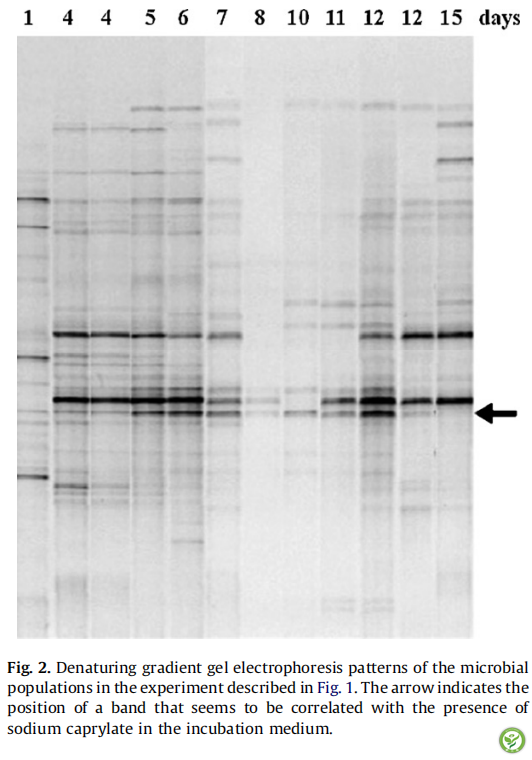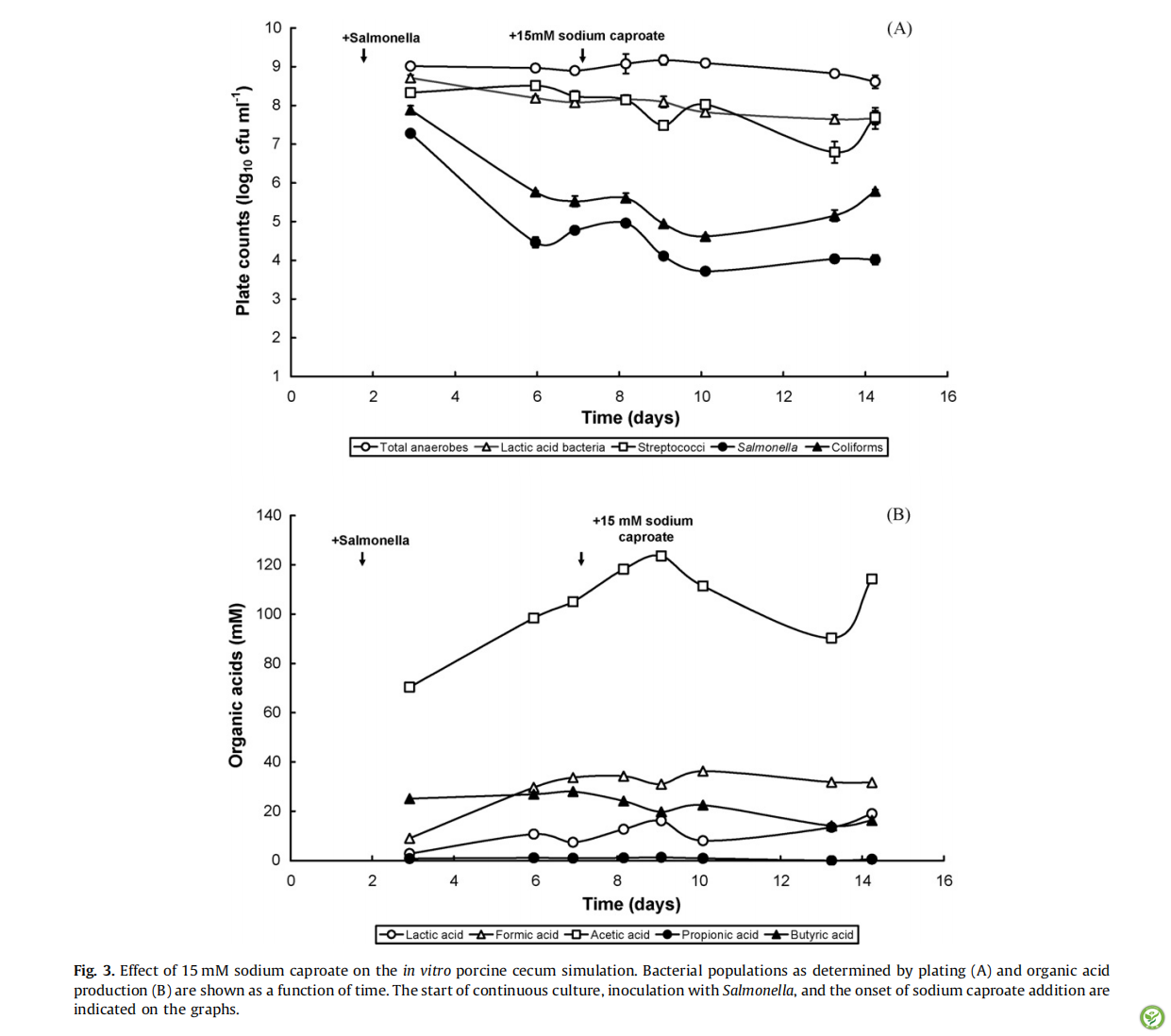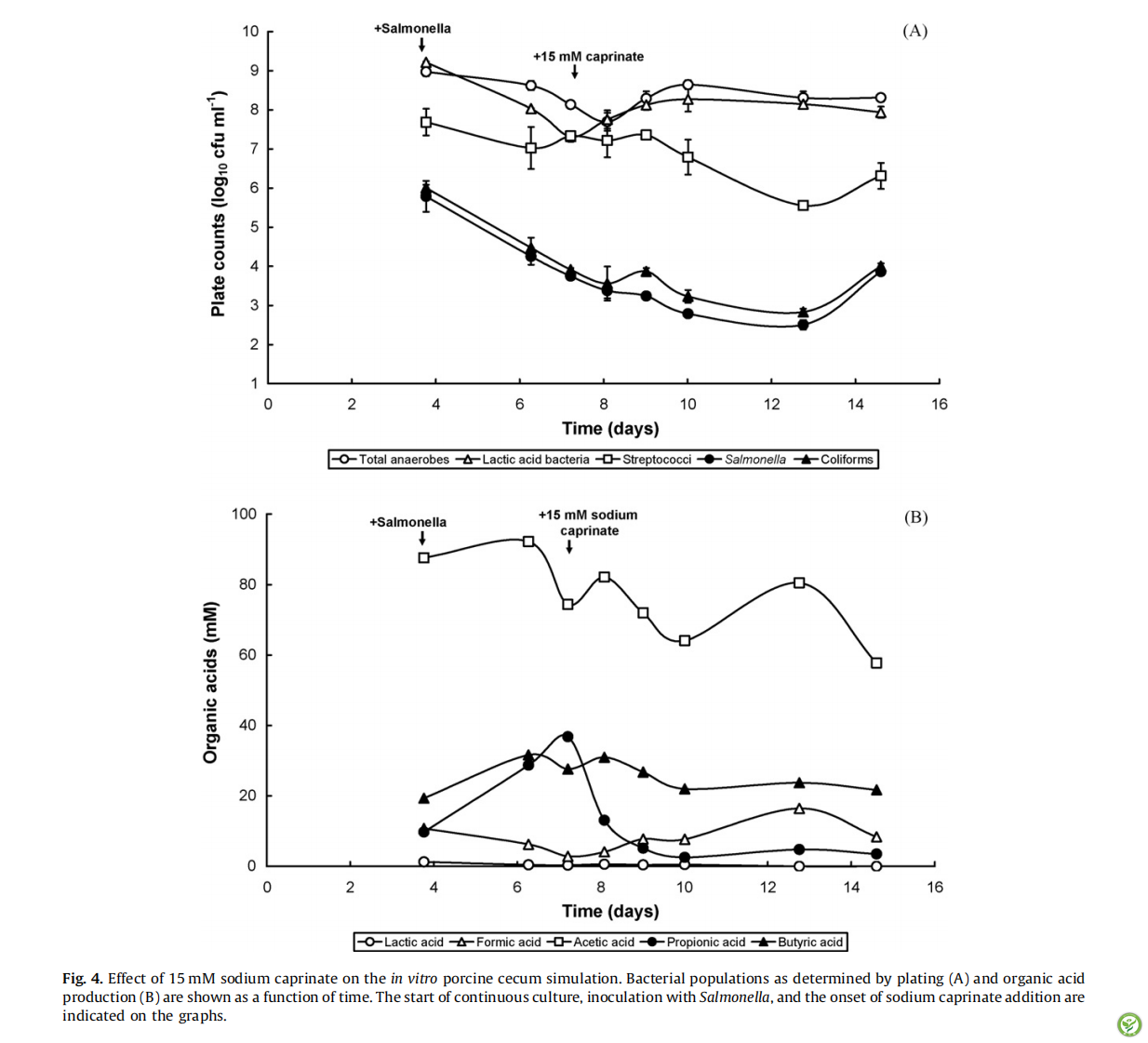原标题:猪盲肠的体外模拟实验:中链脂肪酸抑制鼠伤寒沙门氏菌
Inhibition of Salmonella typhimurium by medium-chain fatty acids in an in vitro simulation of the porcine cecum
作者:Winy Messens a,*, Johan Gorisa, Noel Dierick b, Lieve Hermana, Marc Heyndrickxa
a Institute for Agricultural and Fisheries Research (ILVO), Technology and Food Science Unit Brusselsesteenweg 370, B-9090 Melle, Belgium
bGhent University, Department of Animal Production, Laboratory for Animal Nutrition and Animal Product Quality (LANUPRO), Proefhoevestraat 10,B-9090 Melle, Belgium
来源:Veterinary Microbiology 141 (2010) 73–80
翻译:肠动力研究院 梁琦
【摘要】2007年在比利时,鼠伤寒沙门氏菌的感染人数占当地感染沙门氏菌报告病例的一半以上,并且该菌株是从屠宰猪胴体中分离出的主要血清型。为了减少猪肉被鼠伤寒沙门氏菌污染,可在产业链前端采取措施,例如通过使用饲料添加剂-中链脂肪酸(MCFA))减少沙门氏菌的传播。为研究MCFA(己酸钠,辛酸钠和癸酸钠)对猪肠道微生物菌群的影响,开发了一种模拟猪盲肠的体外连续培养系统。通过在选择培养基上进行平板接种,PCR-DGGE和对发酵产物进行HPLC分析来监测系统。该系统可以维持接种的鼠伤寒沙门氏菌菌株数量约为5 log10 cfu/mL。实验结果显示,通过添加15mM辛酸盐,可以实现大肠菌群和沙门氏菌计数显著减少4.69 log10单位(95%置信区间:4.19-5.18),而其他菌群受影响明显较小。该浓度用于猪饲料中在经济上是可行的,前提是该物质在不被胃和小肠吸收的情况下到达盲肠。因此,辛酸盐(以微胶囊包被或三酰甘油酯的形式),可能具有作为抑制沙门氏菌的猪饲料添加剂的潜力。
【关键词】鼠伤寒沙门氏菌DT104;中链脂肪酸;猪;饲料添加剂;连续培养;胃肠道系统;盲肠
以下是实验中相关图表
表1:添加MCFA对体外猪盲肠模拟的影响。,在MCFA加入后通过平板接种确定的与初始的稳态细菌群落相比的细菌群落的平均变化

图1:15 mM辛酸钠对体外模拟猪盲肠的影响。通过平板(A)和生产的有机酸(B)测定的细菌菌落显示为时间的函数。图中显示了连续培养的开始,沙门氏菌的接种时间,添加和不加辛酸钠的时间

图2:在图1中描述的实验中微生物群的变性梯度凝胶电泳模式,箭头表示条带的位置,该条带似乎与培养基中辛酸钠的存在相关

图3:15 mM辛酸钠对体外模拟猪盲肠的影响。通过平板(A)和生产的有机酸(B)测定的细菌菌落显示为时间的函数。图中显示了连续培养的开始时间,沙门氏菌的接种时间,己酸钠的添加时间

图4:15 mM辛酸钠对体外模拟猪盲肠的影响。通过平板(A)和生成的有机酸(B)测定的细菌菌落显示为时间的函数。图中显示了连续培养的开始时间,沙门氏菌的接种时间,癸酸钠的添加时间

启示
总之,开发并验证了一种猪盲肠中微生物群的体外连续培养模型。因此,该模型未来可用于对盲肠微生物菌群组成的相关研究,以考究以下参数:饲料成分和添加剂,pH值,益生菌菌株的存在等。在本研究中,发现盲肠中的辛酸盐浓度可选择性地抑制的沙门氏菌和大肠杆菌,并且该方法似乎在经济上可行,前提是该物质可以到达盲肠而不被吸收。因此,辛酸盐(以微胶囊或脂肪油的形式),可能具有作为抑制沙门氏菌的猪饲料添加剂的潜力。虽然MCFA甘油酯在消化道的近端区域被吸收(胃25%,回肠75%),但它却对远端区域(盲肠,结肠)的微生物群和代谢有显著影响。与单独使用MCFA甘油酯相比,使用含有脂肪酶的MCFA甘油酯具有额外的优点。
Abstrac
Salmonella typhimurium was responsible for more than half of the reported cases ofhuman salmonellosis in Belgium in 2007 and was the predominant serovar isolated from slaughter pig carcasses. To lower the Salmonella contamination of pork meat, measures can be taken at the primary production level, e.g. by reducing the shedding of Salmonella through the use of feed additives such as medium-chain fatty acids (MCFAs). An in vitro continuous culture system, simulating the porcine cecum, was developed for investigating the effect of MCFAs (sodium caproate, sodium caprylate and sodium caprinate) on the pig intestinal microbial community. The system was monitored by plating on selective media, PCR-DGGE and HPLC analysis of fermentation products. An inoculated S. typhimurium strain could be maintained by the system at a population size of about 5 log10 cfu/mL. By the addition of 15 mM caprylate, significant reductions of coliforms and Salmonella counts by 4.69 log10 units (95% confidence interval: 4.19–5.18) could be achieved, while other bacterial populations were clearly less affected. This concentration seems economically feasible in pig feed, provided that the substance can reach the cecum without being absorbed. Thus, caprylate, for example in the form of encapsulated beads or as triacylglycerol oil, might have potential as a Salmonella-reducing additive in pig feed.
Keywords:Salmonella typhimurium DT104;Medium-chain fatty acid;Pig Feed additives;Continuous culture;Gastrointestinal system;Cecum
如您需原文,请联系本文作者和出版方,或请垂询肠动力研究院。本网站发布的所有资料将尽最大可能注明出处、作者及日期,如无意中侵犯了您的知识产权,请来信及时告知,我们将立即予以删除。
All information released by the WeChat Official Account will do its best to indicate the source, author and date. If we inadvertently infringe on your intellectual property, please inform us in time and we will delete it immediately.




